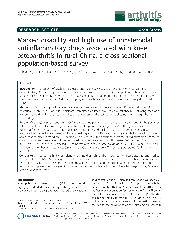摘要
Introduction: The burden of disability, analgesia, and health services use associated with knee pain and osteoarthritis (OA) in developing countries is relatively unknown, despite a high proportion of these populations required to be engaged in heavy occupational physical activity throughout their life span. The aim of this survey was to estimate the burden of disability, analgesia, and health services use associated with knee pain in rural China. Methods: This was a population-based cross-sectional survey among residents, aged 50 years and older, of Wuchuan County, Inner Mongolia. Participants completed an interviewer-based questionnaire, evaluating knee pain and associated disability, analgesia, and health services use, and obtained bilateral standardized weight-bearing knee radiographs. Results: Of the 1,027 participants, 513 (50%) reported knee pain on most days of at least 1 month in the past year, with 109 (21%) also demonstrating radiographic OA (Kellgren-Lawrence grade >= 2) in the symptomatic knee. Adjusting for age, gender, body mass index (BMI), education, and back pain, the presence of knee pain was associated with significantly greater difficulty in walking, climbing 10 steps, stooping, completing cleaning chores, and preparing meals. Among the 513 subjects with knee pain, the additional presence of radiographic evidence of OA was significantly associated with more occasions of "unbearable" pain (59% versus 36%) and restricted activity (64% versus 39%), as well as increased use of nonsteroidal antiinflammatory drugs (NSAIDs) (88% versus 78%) and the reported number of doctor visits (59% versus 33%) in the past year. The use of paracetamol for knee pain was rare (6% versus 2%). Conclusions: Knee pain is highly prevalent in rural northern China. The associated significant disability and marked preferential use of NSAIDs as analgesia should be of concern in these communities reliant on heavy occupational physical activity for their livelihood. The findings will be useful to guide the distribution of future health care resources and preventive strategies. A similar article has been published in the Chinese language journal, National Medical Journal of China.
- 出版日期2010
- 单位北京大学
